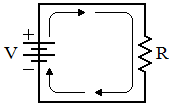
This figure shows direction of current flow in a circuit with respect to the voltage source.
| Voltage and Current Basics |
| Equation for voltage | ||||||
| Equation for current |
| v | voltage in volts |
| w | energy in joules |
| q | charge in coulombs |
| i | current in amperes |
| q | charge in coulombs |
| t | time in seconds |
| (Eq1) |
|
| (Eq2) |
|
 This figure shows direction of current flow in a circuit with respect to the voltage source. |